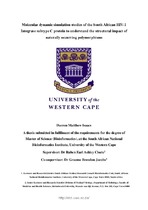| dc.contributor.advisor | Cloete, Ruben Earl Ashley | |
| dc.contributor.author | Isaacs, Darren Mathew | |
| dc.date.accessioned | 2021-08-19T10:50:23Z | |
| dc.date.available | 2021-08-19T10:50:23Z | |
| dc.date.issued | 2021 | |
| dc.identifier.uri | http://hdl.handle.net/11394/8365 | |
| dc.description | >Magister Scientiae - MSc | en_US |
| dc.description.abstract | The viral Integrase (IN) protein is an essential enzyme of all known retroviruses, including HIV-1. It is responsible for the insertion of viral DNA into the human genome. It is known that HIV-1 is highly diverse with a high mutation rate as evidenced by the presence of a large number of subtypes and even strains that have become resistant to antiretroviral drugs. It remains inconclusive what effect this diversity in the form of naturally occurring polymorphisms/variants exert on IN in terms of its function, structure and susceptibility to IN inhibitory antiretroviral drugs. South Africa is home to the largest HIV-1 infected population, with (group M) subtype C being the most prevalent subtype. An investigation into IN is therefore pertinent, even more so with the introduction of the IN strand-transfer inhibitor (INSTI) Dolutegravir (DTG). | en_US |
| dc.language.iso | en | en_US |
| dc.publisher | University of Western Cape | en_US |
| dc.subject | HIV-1 | en_US |
| dc.subject | South Africa | en_US |
| dc.subject | Integrase subtype C | en_US |
| dc.subject | Protein | en_US |
| dc.subject | Antiretroviral drugs | en_US |
| dc.title | Molecular dynamic simulation studies of the South African HIV-1 Integrase subtype C protein to understand the structural impact of naturally occurring polymorphisms | en_US |
| dc.rights.holder | University of Western Cape | en_US |

